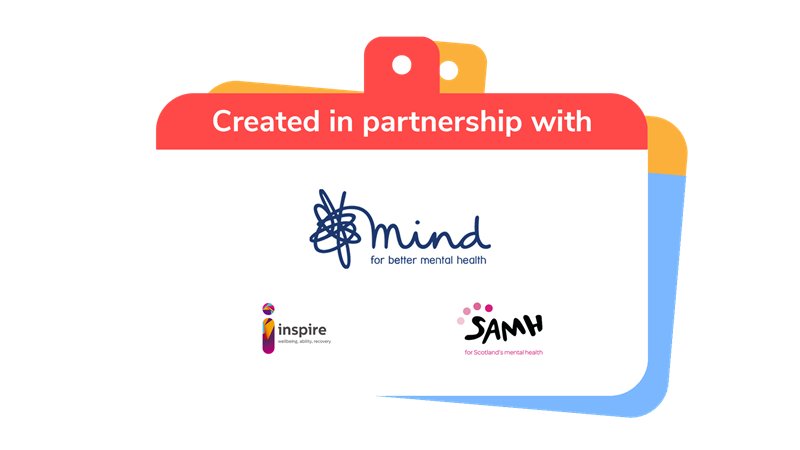
Organise a de-stresstival
You’ll need
- Craft materials (for example, tissue paper, pipe cleaners, stickers)
- Appropriate items and materials to run your de-stresstival
Plan the event
- Explain that everyone will work together to plan and run a ‘de-stresstival’ – a wellbeing event to promote better mental health for all.
- Everyone should work together to choose a date, time, and location for their day. They may need to choose a few dates, just in case their venue’s busy. Everyone should use the ‘Event planning checklist’ to make sure they’ve thought of everything.
- Everyone should chat about what they’ve learned about mental health. They should think about the activities they’ve done already – what would they like to share with other people?
- Everyone should work together to decide the purpose of their event. How will it promote better mental health for all? For example, it could raise awareness of local services or give people the opportunity to take part in activities that boost wellbeing.
- Once they’ve decided the purpose of their event, everyone should come up with plenty of ideas for activities they could run.
- Everyone should narrow down their list. They should think about the practicalities of the different options, including the resources they have, how long their event will last, and who’ll deliver each activity.
- Everyone should plan how they’ll make sure all of their activities are accessible. Will they set up tables so they’re accessible for wheelchair users? What about if someone doesn’t want to talk about their own experiences?
- Everyone should identify a space to turn into a ‘quiet space’ for anyone to use if they want a break from the activities. They should also plan what they’ll put in it – how about comfy seats and calm activities like colouring?
- Everyone should decide who they’d like to invite – they could stick to friends and family, or advertise the event to the whole community. They should work together to make any invitations or posters they need.
- Everyone should work together to make signs that make it clear what’s happening in each area (and where the toilets are!). The signs should use images as well as words.
On the day
- Everyone should set up the things they need for each activity, put up their signs, and prepare the quiet space. They should make sure everything’s clearly labelled so people know what’s happening where.
- When the visitors arrive, everyone should greet them and make them feel welcome. They could start conversations, for example, by asking where people found out about the event or how their journey there was.
- Everyone should run the activities they’ve planned.
- At the end of the event, everyone should give the visitors a chance to feed back. What worked well? What could they do differently next time?
- Everyone should work together to pack everything away, recycle as much as possible, and leave the venue as they found it.
Activity ideas
- Run an introduction session for mindfulness, meditation, yoga, or Pilates
- Make ‘five ways to wellbeing’ chatterboxes, wellbeing boxes, or wellbeing wheels
- Make a ‘five ways to wellbeing’ pledge board
- Set up a photo booth where people can take photos with pledge cards or personal messages about mental health
- Have a guest speaker who’ll talk about mental health
- Show off some themed art with a poetry recital, or art or photography exhibition
- Put on a musical performance relating to wellbeing or mental health
- Run an art station where people can get creative and express their feelings (including their feelings about mental health)
- Launch a community wellbeing map
- Run a wellbeing walk for everyone

This activity helps contribute towards some of the UN's Sustainable Development Goals. Find out more about the SDGs, and how Scouts across the world are getting involved.




Reflection
This activity was all about helping the community. Events can be great ways to take an active role in the community. What went well with this event? Did it help other people? How did it make the world (even if just a corner of it) a better place? What did everyone learn from the event? It’s OK if some things didn’t quite work – it’s all about learning. Will people share the news about their event anywhere? People could think about sharing photos online, writing a blog, or sending information to local media.
This activity was also about being a local, national, and international citizen. Why is it important to help on a local level as well as a huge international level? As long as the event made a positive different for at least one person, it had a real impact. How could everyone work towards making things better for other people nationally and even internationally? People may think about contacting decision makers or working alongside charities and organisations.
Safety
All activities must be safely managed. You must complete a thorough risk assessment and take appropriate steps to reduce risk. Use the safety checklist to help you plan and risk assess your activity. Always get approval for the activity, and have suitable supervision and an InTouch process.
- Outdoor activities
You must have permission to use the location. Always check the weather forecast, and inform parents and carers of any change in venue.
- Road safety
Manage groups carefully when near or on roads. Consider adult supervision and additional equipment (such as lights and high visibility clothing) in your risk assessment.
You could increase the level of challenge by aiming high with your event – maybe you could take part in a campaign, make a positive change in your local area, or send a message to decision makers. You could invite local decision makers or local media.
Why not work with another group to make your event bigger and share resources?
There’s a role for everyone in events like this, whether they want to be the centre of the attention or behind the scenes. Make sure everyone’s got the encouragement and support they need – no one should take on too much.
Mental health is complicated – positive wellbeing activities can’t always make mental health problems better (no matter how great they are). This isn’t anybody’s fault, and it’s always OK to need some more support for mental health problems. Remind people that talking to a trusted adult, a GP, or Childline are all great places to start (and always follow the Yellow Card).
Be sensitive if anyone has experience of mental health problems. Let them (and their parents or carers) know about the activity in advance and find out if there are any topics you should avoid. People only have to share as much as they want to. No one has to share their deepest secrets or feelings if they feel uncomfortable – they can still chat about their wellbeing and things that help on a day-to-day basis.
All Scout activities should be inclusive and accessible.
If anything went really well, think about where else you could use it. Perhaps you could commit to having a wellbeing hour at every camp, for example.
If you’re feeling ambitious (or if your first de-stresstival went well), you could even expand the idea into a ‘wellbeing weekend’. You could combine this with a camp or trip you’ve already planned by including an activity for each of the five ways to wellbeing (and reflecting on people’s thoughts and feelings afterwards).
Discover more at https://www.mind.org.uk/



